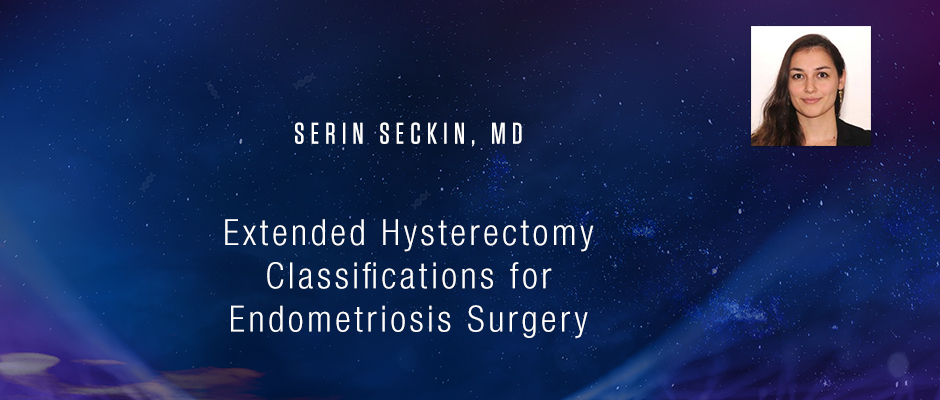Serin Seckin, MD - Extended Hysterectomy Classifications for Endometriosis Surgery
Endometriosis Foundation of America
Medical Conference 2019
Targeting Inflammation:
From Biomarkers to Precision Surgery
March 8-9, 2019 - Lenox Hill Hospital, NYC
https://www.endofound.org/medicalconference/2019
Hello, it's a great honor to be speaking up here today after being in the audience for so many years. So I know we don't have too much time. So I'll very quickly go through this topic. I want to propose a possible classification for endometriosis surgery when hysterectomy is performed. And any input at the end of the presentation is welcome. So I'll skip the overview.
Didn't think this would happen to me ... Okay.
So why even define this at all? Why define hysterectomy at the time of endometriosis surgery? Why classify any of this? We'll go through a couple of the reasons why I think this should be. So after completion of family planning, hysterectomy may very well be part of surgery for a patient who's getting endometriosis surgery, whether or not ovaries are removed at that time is up to the discretion of the surgeon and the patient and the patient's age and extent of disease. But the important thing to remember is that hysterectomy is not the definitive cure for endometriosis in many cases and if tissue is left behind, the patient may not be cured and may still have pain. Important to note that 12% of surgeries performed at the time of endometriosis surgery includes hysterectomy.
Hysterectomy itself can technically be an extremely difficult procedure when done when the patient has advanced endometriosis. And this brings us to the challenge of multi-organ involvement when a hysterectomy is being performed. A patient may have involvement of the bladder, rectum, perimetrium, and this at the time of surgery may present unique challenges. So this brings us to surgeon familiarity and makes us recognize that many gynecologists are not familiar with the technique required to successfully excise endometriosis lesions at the time of the hysterectomy. They may be challenged and face complicated outcomes with regard to both intraoperative and postoperative courses involving these cases, so it's just something to think about.
In terms of current practices, first I just wanted to talk briefly about comparing total operative time with laparoscopic hysterectomy. So for endometriosis surgery and hysterectomy, times can range from ... If it's a simple hysterectomy with small peritoneal excision can range from 100 minutes to up to 300 minutes if there are more complicated organ resections done. In terms of laparoscopic hysterectomy for endometrial carcinoma without any extending disease, it can take less than ... The average time in one study was 116 minutes for cervical carcinoma, when radical hysterectomy is performed laparoscopically, the average time is 238 minutes. When a simple hysterectomy is performed for an indication such as abnormal uterine bleeding with a uterine size less than 250 grams, the operative time is really based on the expertise of the surgeon but sometimes it can be as little as 45 minutes. So, important to remember that when excision is being done at the time of hysterectomy with patients with advanced endometriosis or endometriosis to any great degree, it can really take more time and require more expertise.
So, how are hysterectomies coded? There are only a few criteria in the coding system which you can play with when determining how to report to insurance companies and report in your medical records what was done. Uterine size is one of those, so less than or more than 250 grams, whether or not it was supracervical or not, whether or not it was a radical hysterectomy and whether or not surgery was done with de-bulking for the purpose of cancer surgery. And that's pretty much it.
Goals for reclassification of hysterectomy time at time of endometriosis surgery and presenting this at all is to potentially change the medical coding system so maybe if we do make a classification system we'd have better record-keeping. It may influence the coding system in the future to accurately code the procedure that was performed. This may have great benefit in terms of improving research as well when going back and doing retrospective chart searches and it may potentially motivate providers to concentrate their time and efforts in becoming proficient at endometriosis surgery. This is long down the line.
So in terms of modifying hysterectomy for endometriosis surgery, again we already discussed that a simple hysterectomy alone may not be sufficient for more advanced stages of endometriosis. And extrafascial approaches for hysterectomy at the time of endometriosis surgery often involve techniques that are also used in hysterectomy for carcinoma of the cervix. So one group defined a tailored radical hysterectomy that would also involve removing more extensively into the perimetrium and possibly the vagina as well for deeply infiltrating nodules.
So what we're going to propose is a little bit more classified into stages, from simple to more involved but this is a jumping off point for sure. This is a model of the pelvis that we'll be discussing going through each class. We'll briefly being going through all of these. I won't go through it right now. Class I is a simple hysterectomy with peritoneal excision of any location. No limits to the width of the excision as long as it doesn't involve deep organ excision or deep cul-de-sac excision. So this is a picture of superficial excision around the peritoneum as well with blue dye and then the uterine arteries are tied as close to the cervix as possible.
A Class 2A would be a extrafascial hysterectomy with excision of any superficial peritoneum. So Class 1, like we said, plus the addition of uterine artery ligation lateral to the ureter but proximal to the obliterated umbilical artery. This can also involve, so and/or, nodule resection of the cul-de-sac or rectum, without entering rectal mucosa. And again this is a picture depiction of this with the uterine arteries tied lateral to the ureters with a rectal nodule resection not entering the mucosa.
So a Class 2B would be the same thing but with resection and repair of a rectal nodule that may involve mucosa or resection repair of a bladder mucosa. And there can be more things added to this, it's still in progress here. And removal of perimetrium. So no picture for that but we'll class to skip 3A.
So this is when the hypogastric arteries ligated due to significant involvement of the pelvic sidewall and if bowel resection, bladder resection, ureter resection or diaphragm resection with reanastomosis of the organ is also involved and of course, like we talked about in the conference, if there is any resection of nerves, like the sciatic nerve or perhaps a rectal [inaudible 00:08:26] resection as well, this could be categorized under Class 3A.
And Class 3B would be when multiple organ resections are necessary. This is our pictures here. And just reviewing the levels of uterine artery ligation. So A is Class 1, B is Class 2 and C is Class 3. There are many areas to improve upon here so this doesn't reflect at all the extent of adhesions, I didn't reflect specifically on other organ involvement and we didn't talk about how or not to classify whether there's [inaudible 00:09:03] endometrioma removal at the same time or whether ovaries are concerned. And time of procedure is also not involved in the classification and usually it is not in most hysterectomy classifications.
In conclusion, hysterectomy performed at the time of endometriosis surgery is not so simple and we all know that. It has the potential to require significant time and expertise and a team-based approach to accomplish and finish. And a hysterectomy may have a lot of implication on a woman's life so we believe that the efforts that the caregivers put forth as well should be recognized by having an adequate coding in the future, for both endometriosis excision and for hysterectomy done with endometriosis excision. And ultimately we aim to make the coding system change and the nomenclature change as well with respect to the merit of the procedure and this may benefit future efforts when it comes to research as well.
And that's it. Thank you.










